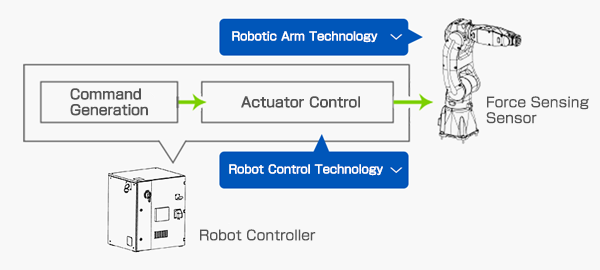Core technologies
It has been 100 years since we have driven a motor.
Yaskawa’s DNA is to be a technology-driven company. The company is committed to developing new technologies for “motors and their application” every day.
It has been 100 years since we have driven a motor.
Yaskawa’s DNA is to be a technology-driven company. The company is committed to developing new technologies for “motors and their application” every day.

Industrial robots are widely used for automation in welding, painting, assembly, and transportation in a variety of industries, including the automotive market, the 3C market (computers, communications, and consumer electronics), and the triple product market (food, pharmaceuticals, and cosmetics). Industrial robots and robotics technology consist mainly of an arm, which is a mechanical part, and a robot controller that controls the arm’s movement.
The typical arm mechanism for industrial robots is the vertical articulated type, which is Yaskawa’s flagship product. Other types of robots have horizontal articulation (scalar) and parallel link mechanisms, where robotic arm technology is applied to achieve these mechanisms. Robotic arm technology is a group of technologies that integrates the design and manufacturing of mechanisms, such as arm structures, actuators (motor and reducer modules), power transmission mechanisms, and link shapes.
Robot control technology enables the arms of industrial robots to perform specific actions. This technology includes high-speed, high-precision motion control by coordinating multiple motors to suppress arm-hand vibration, and planning technology that automatically calculates an efficient and optimal path and work order, such as an arm avoiding obstacles. Motion control includes kinematics, interpolation technology, and sensing technology. In addition, we develop digital twin technology that integrates motion control technology and planning technology through IoT.